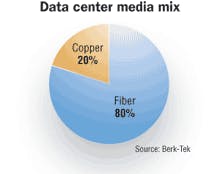Data centers are being required to store more data than they can efficiently handle, and a recent TIA standard comes just in time to sort out the mess.
These were the thoughts of Tom Debiec, technical marketing specialist for Berk-Tek, A Nexans Company, who spoke during the recent Berk-Tek Technology Summit in late September at the company’s facility in New Holland, PA.
Debiec says today’s data centers are feeling the aftershocks of storing vast amounts of data. “Did we need another standard? Yes,” he said.
TIA-942 is the first extensive standard to address data centers. The Telecommunications Industry Association (TIA) published the standard, titled “Telecommunications Infrastructure Standard for Data Centers,” in April. The standard is designed to provide requirements and guidelines for the design and installation of a data center or computer room. It is intended for use by designers who need a comprehensive understanding of the data center design, including facility planning, the cabling system and the network design.
The standard is intended to enable the data center design to be considered early in the building development process. The TIA formed the standard to promote cooperation in the design and construction phases.
The standard provides requirements and guidelines for the design and installation of a data center or computer room. It is intended to be used by designers who need comprehensive understanding of data center design. The document covers such topics as cabling network design, fire protection, water intrusion, and redundancy. It tells data center designers how to select cabling that will have a useful life cycle, how to occupy a specifically-sized data center with racks and other equipment, and what channel capacity the cabling system should have.
Debiec said designing your data center in accordance with the new standard will help ensure robust data center design, standardized organization, ready supply, less re-work and scalability for future applications.
This sort of guidance is much needed, Debiec said, since enterprise end users face escalating requirements for data storage in data centers that typically have 80% copper cabling, and 20% optical fiber.
Debiec said large enterprises are seeing 50% yearly data growth. Data storage has increased as companies try to adhere to data-keeping requirements made by the Sarbanes-Oxley Act, health insurance portability and accountability, the Graham-Leach-Bliley Financial Services Modernization Act, the U.S. Federal Reserve, and rules by the Securities & Exchange Commission--to name just a few.
Because of this data storage surge, Debiec said enterprise end users are being forced to undertake major technological shifts in their data centers, and these will cost U.S. companies and institutions an estimated $7.4 billion by 2009.
To give an example, Debiec said a 10,000-square-foot data center will experience a 50% annual capacity increase. It will also see a doubling of floor space requirements every three to five years at a cost of $700 to $1,200 per square foot. Upgrades would cost $8 to 12 million over a three-year period.
All of this led to what Debiec sees as a huge growth in storage area networks (SANs) during the last five years. It’s growth that too often leads to cables overflowing in a data center. “Was this a big surprise that data would increase this much?” he asked.
“Racks are filled, and we have to put them in another part of the data center or try to do it with patch cables,” he said. “Then you have spaghetti. This is why you need good planning up front.”
Debiec said TIA-942 provides a guideline for that planning, and it specifies a generic telecommunications cabling system for the data center and related facilities whose primary function is information technology.
“We need to have some sort of documents, and say, ‘This is how we do it at every facility in the world,” said Debiec. “It needs to be completely uniform.”

